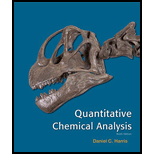
a)
Interpretation:
The oxidizing agent on the left side of the reaction and balanced half reaction has to be written.
Concept Introduction:
Oxidizing agent:
An oxidizing agent or oxidant is a substance that gains electrons and gets reduced in a
Half Reactions:
A half reaction can be defined as component of redox reaction that is either
b)
Interpretation:
The reducing agent of the left side of the reaction and balanced half reaction has to be written.
Concept Introduction:
Reducing agent:
A reducing agent or reductant is a substance that loses electrons and gets oxidized in a chemical reaction. A reducing agent is also called as electron donor.
Half Reactions:
A half reaction can be defined as component of redox reaction that is either Oxidation or reduction reaction. The change in oxidation states of individual substances present in redox reaction gives the half reaction. Half reactions are common methods of balancing redox reactions.
c)
Interpretation:
The number of Coulombs of charge passed from reductant to oxidant when
Concept Introduction:
Electric charge:
Electric charge (q) is given in Coulombs (C). The magnitude of charge of a single electron or proton is
The electric charge in coulombs can be expressed as,
Where,
q=coulombs
n=unit charges per molecule
N=moles
F=
The units work since the number of unit charges per molecules, n is dimensionless.
d)
Interpretation:
The flow of current (in amperes) from reductant to oxidant has to be calculated.
Concept Introduction:
The quantity of charge that flows in each second through a circuit is called as electric current. Ampere is the unit of electric current and is expressed as A.
A current of one Ampere tells about a charge of one coulomb per second flowing across a point in a circuit.
Want to see the full answer?
Check out a sample textbook solution
Chapter 14 Solutions
Quantitative Chemical Analysis
 ChemistryChemistryISBN:9781305957404Author:Steven S. Zumdahl, Susan A. Zumdahl, Donald J. DeCostePublisher:Cengage Learning
ChemistryChemistryISBN:9781305957404Author:Steven S. Zumdahl, Susan A. Zumdahl, Donald J. DeCostePublisher:Cengage Learning ChemistryChemistryISBN:9781259911156Author:Raymond Chang Dr., Jason Overby ProfessorPublisher:McGraw-Hill Education
ChemistryChemistryISBN:9781259911156Author:Raymond Chang Dr., Jason Overby ProfessorPublisher:McGraw-Hill Education Principles of Instrumental AnalysisChemistryISBN:9781305577213Author:Douglas A. Skoog, F. James Holler, Stanley R. CrouchPublisher:Cengage Learning
Principles of Instrumental AnalysisChemistryISBN:9781305577213Author:Douglas A. Skoog, F. James Holler, Stanley R. CrouchPublisher:Cengage Learning Organic ChemistryChemistryISBN:9780078021558Author:Janice Gorzynski Smith Dr.Publisher:McGraw-Hill Education
Organic ChemistryChemistryISBN:9780078021558Author:Janice Gorzynski Smith Dr.Publisher:McGraw-Hill Education Chemistry: Principles and ReactionsChemistryISBN:9781305079373Author:William L. Masterton, Cecile N. HurleyPublisher:Cengage Learning
Chemistry: Principles and ReactionsChemistryISBN:9781305079373Author:William L. Masterton, Cecile N. HurleyPublisher:Cengage Learning Elementary Principles of Chemical Processes, Bind...ChemistryISBN:9781118431221Author:Richard M. Felder, Ronald W. Rousseau, Lisa G. BullardPublisher:WILEY
Elementary Principles of Chemical Processes, Bind...ChemistryISBN:9781118431221Author:Richard M. Felder, Ronald W. Rousseau, Lisa G. BullardPublisher:WILEY





